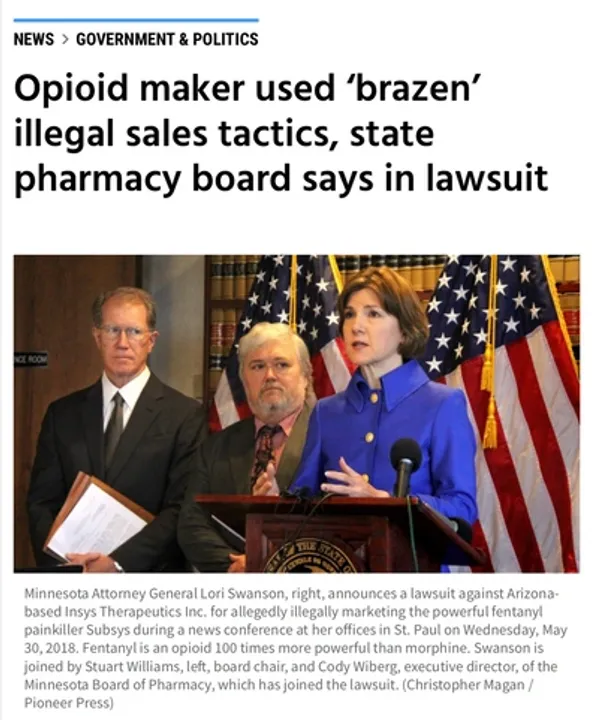at 612-315-3037 or
www.swansonhatch.com

According to the National Association of County and City Health officials (“NACCHO”), the peak death rate by guns was 40,000 in 1993. The peak death rate by HIV was 48,000 in 1995, and the peak death rate by automobiles was 55,000 in 1972. There were 64,000 drug overdoses in 2016, killing 42,000 Americans. Drug overdoses have killed more Americans than died in all wars put together since World War II.
By some reports, approximately 25% of people who are prescribed opioids for chronic pain misuse them. Looking at it from the opposite lens, about 80% who use heroin first misused prescription opioids.
Opioids cause more than 1,000 emergency room visits per day, and the National Association on Drug Abuse reports that a baby is born with opioid addiction every 20 minutes. Twenty years ago, 4% of the men between 25 and 54 were absent from the workforce due to addiction. Today, it is estimated to be 11% of the workforce.
Lori Swanson issued a report on opioids in 2016, making a series of policy reform and legislative recommendations. The report was quite comprehensive in its approach, proposing changes to addiction treatment, criminal justice reforms, protocols for physicians, better prescription drug monitoring programs, better disposal of opioids, better public awareness, better access to naloxone, mandatory health provider continuing education, and more aggressive action by health professional boards. The National Conference of State Legislatures recognized Attorney General Swanson’s work by giving the Report its 2017 Notable Documents Award.
In May of 2018, Swanson filed a lawsuit against Insys Therapeutics, an Arizona manufacturer of fentanyl using the brand name Subsys. In 2012, Subsys was approved by the FDA for one purpose: to treat breakthrough pain in cancer patients who have grown tolerant of other opioid treatment. Because fentanyl is life threatening, the FDA approval was limited: It was not to be used until the prescriber, the patient and dispensing pharmacy were familiar with the medication’s Risk Evaluation and Mitigation Strategy (REMS).
Once approved, Insys began marketing the drug for “off label” uses. While a physician may, within certain limits, use a medication for an “off-label” purpose, the manufacturer may not promote off-label use.
In spite of these restrictions, the company aggressively marketed the drug for consumption beyong those cancer patients who had grown tolerant of standard opioids. Insys representatives searched pharmacy data to find high prescribers of other analgesics. It then had its sales representatives target target those prescribers for sales. On top of that, Insys initiated a program to pay physicians “speaker fees” and have them market the drug as being appropriate for “mild” pain. Insys also began a program of informing physicians that it was just as dangerous to under-prescribe Subsys as it was to overprescribe it.
The lawsuit against Insys was pending at the end of Swanson’s term of office.
References: